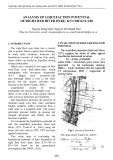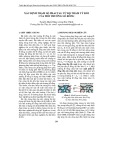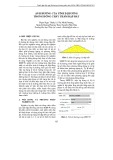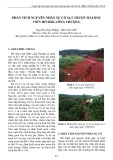
* Corresponding author. Fax:+91 361 2841949
E-mail address: jnvishwakarma@rediffmail.com (J. N. Vishwakarma)
2018 Growing Science Ltd.
doi: 10.5267/j.ccl.2018.03.001
Current Chemistry Letters 7 (2018) 35–44
Contents lists available at GrowingScience
Current Chemistry Letters
homepage: www.GrowingScience.com
Ultrasound assisted synthesis of 1-amino-3-ferrocenyl-3-oxoprop-1-enes
Jai N. Vishwakarma*, Shilpika Khanikar, Utpalparna Kalita, Shunan Kaping and Madhushree Ray
Organic Research Lab., Department of Chemical Science, Assam Don Bosco University, Tapesia Campus, Tapesia Gardens, Kamarkuchi, Sonapur-
782402, Assam, India
C H R O N I C L E A B S T R A C T
Article history:
Received December 22, 2017
Received in revised form
March 20, 2018
Accepted March 25, 2018
Available online
March 25, 2018
A clean and efficient, mediated in water and assisted by ultrasound method for the synthesis of
a series of N-substituted 1-amino-3-ferrocenyl-3-oxoprop-1-enes starting from acetyl
ferrocene was developed. Our approach offers shortening of the reaction time under the mild
reaction conditions and easy work up procedure.
© 2018 Growing Science Ltd. All rights reserved.
Keywords:
Enaminones
Michael addition
Nucleophilic substitution
Crystal structure
1. Introduction
Studies on the chemistry of ferrocene1-3 have attracted the interest of many scientists and research
groups due to its applications in material science,4 asymmetric synthesis4 and biology.5,6 The ferrocene
derivatives exhibit also an antiplasmodial,7-9 antitumor,10 and DNA cleaving12 activities, have an
antiproliferative effects on the MCF7 cell lines,11 activity and have chemotherapeutic action on drug-
resistant cancer.4,13
On the other hand, enaminones are important building blocks in the synthesis of many heterocyclic
compounds14 and many therapeutic: antitumor,15 antimicrobial,15-17 anticonvulsant,18 anti-
inflammatory,19 analgesic,19 ulcerogenic agents.20 Keeping in view the biological importance of
enaminones,18,21 we have recently reported22 the synthesis of (Z)-3-adamantyl-1-aryl-prop/but-2-en-1-
ones which were tested for anti-inflammatory and anticancer properties. Also, not much work has been
done on the synthesis of enaminones containing the ferrocenyl moiety except for an isolated report on
the synthesis of 1-benzylamino-3-ferrocenyl-3-oxoprop-1-ene by Moskalenko et al.25 In continuation
with our ongoing studies on enaminones22-24 and with the interest in exploring the chemistry of
ferrocene due to its unique properties, we decided to develop synthetic strategy for enaminones
containing the ferrocene moiety.






























